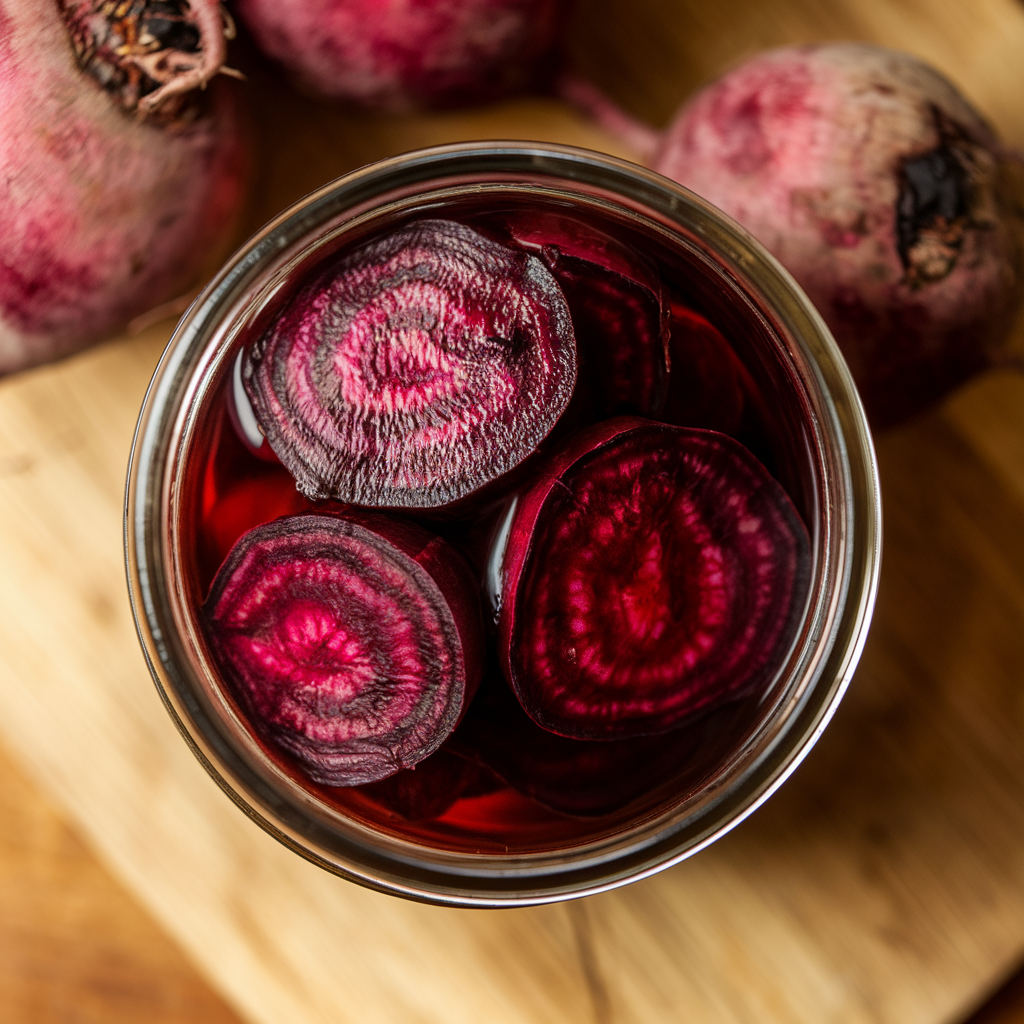
DiscoverHow to Ferment Beets Recipe to enhance their flavor and nutrition. Learn the step-by-step process, ingredients, and tips for fermenting beets effectively.
Introduction
Fermented foods have been gaining popularity in recent years, and for good reason. Not only do they add an extra zing to your meals, but they also come with numerous health benefits. Fermented beets are no exception—they’re packed with probiotics that promote gut health and bring a delightful tangy flavor to your dishes. Moreover, in this article, you’ll learnHow to Ferment Beets Recipe that is simple, nutritious, and bursting with flavor. Whether you’re new to fermenting or have some experience, this comprehensive guide will help you create perfect fermented beets at home.
Fermentation has been used for centuries as a method of preserving food, improving flavor, and boosting nutritional value. Additionally, beets, with their natural sweetness and high nutrient content, are particularly well-suited for fermentation. By fermenting beets, you not only extend their shelf life but also transform their flavor profile into something wonderfully complex. Moreover, this guide will walk you through everything you need to know, from selecting the right beets to ensuring they ferment perfectly.
Table of Contents
- What Are Fermented Beets?
- Benefits of Fermenting Beets
- Ingredients Needed for Fermented Beets
- Tools Required for Fermentation
- Step-by-Step Guide: How to Ferment Beets
- Preparing the Beets
- Making the Brine
- Fermentation Process
- How to Store and Enjoy Fermented Beets
- Common Issues in Beet Fermentation and Troubleshooting Tips
- Tips for Flavor Customization
- Health Benefits of Fermented Beets
- FAQ Section
- Recipes Using Fermented Beets
- Conclusion
1. What Are Fermented Beets?
Fermented beets are essentially beetroot that has been preserved through the process of lacto-fermentation. This traditional method uses saltwater brine to encourage the growth of beneficial bacteria while inhibiting harmful microorganisms. The end result is beets that are not only safe to eat but also loaded with probiotics, flavor, and enzymes that help with digestion.
Fermented vegetables are popular across many cultures, from sauerkraut in Germany to kimchi in Korea. Fermenting beets is just another way to diversify your diet while ensuring you get plenty of beneficial nutrients.
The lacto-fermentation process works by converting the sugars in beets into lactic acid, which acts as a natural preservative. This method helps maintain the vibrant color and crisp texture of the beets while adding a pleasantly sour note that enhances their natural sweetness.
2. Benefits of Fermenting Beets
There are several reasons to include fermented beets in your diet:
- Rich in Probiotics: Fermented beets are full of beneficial bacteria that help maintain a healthy gut.
- Improved Digestion: Due to the fermentation process, beets become easier to digest.
- Nutrient Preservation: Vitamins, minerals, and antioxidants in beets are preserved and sometimes enhanced by fermentation.
- Delicious Flavor: Fermentation adds a tangy, unique flavor to the otherwise earthy beet taste.
- Boosted Immune System: The probiotics found in fermented beets can help support immune function by maintaining a balanced gut microbiome.
- Reduced Sugar Content: The natural sugars in beets are partially broken down during fermentation, which may make them a better option for those looking to reduce their sugar intake.
These health benefits, along with improved shelf-life and taste, make fermenting beets an excellent choice.
3. Ingredients Needed for Fermented Beets
Below is a list of ingredients that you’ll need to prepare this recipe:
| Ingredient | Quantity |
|---|---|
| Fresh Beets | 1 kg (2.2 lbs) |
| Sea Salt | 2 tbsp |
| Water (filtered) | 4 cups |
| Optional Spices | Garlic, dill, caraway seeds, black peppercorns |
These basic ingredients are enough to start fermenting your beets and create your own version of this nutritious delight. You can also experiment with different spice combinations to create unique flavors.
4. Tools Required for Fermentation
To ensure successful fermentation, make sure you have the following items:
- Large Mason Jar (or fermentation crock)
- Knife and Cutting Board
- Clean Towel or Lid
- Weight for Fermentation (like a smaller jar or special fermentation weight)
- Mixing Bowl
- Wooden Spoon (to pack the beets tightly)
These items will simplify the fermentation process, making it straightforward for beginners and advanced fermenters alike.
5. Step-by-Step Guide: How to Ferment Beets Recipe
5.1 Preparing the Beets
- Clean the Beets: Begin by thoroughly cleaning the beets under cold water to remove any dirt. Since we want to preserve the nutrients and probiotic benefits, avoid peeling the beets unless they have damaged skin.
- Cut the Beets: Slice the beets into uniform pieces—either thick rounds or cubes. Uniform cutting ensures that the beets ferment evenly.
- Blanching (Optional): Some people prefer blanching their beets before fermentation to soften the texture. This step is optional, depending on your preference.
5.2 Making the Brine
The key to effective fermentation is the saltwater brine. Follow these steps:
- Mixing the Brine: Dissolve 2 tablespoons of sea salt in 4 cups of filtered water. Make sure the salt dissolves completely before using it.
- Adding Spices: This is where you can add optional spices like garlic cloves, dill, or black peppercorns for added flavor. Place these at the bottom of the jar to ensure even seasoning.
5.3 Fermentation Process
- Pack the Beets in the Jar: Place the beet pieces inside a large mason jar, ensuring there’s enough space at the top for the weight. Use a wooden spoon to press the beets down to remove air pockets.
- Pour the Brine: Slowly pour the brine over the beets, covering them completely. Leave about an inch of space at the top.
- Add the Weight: Place a fermentation weight or a smaller jar inside the mason jar to keep the beets submerged. This is crucial to prevent mold from growing.
- Cover and Wait: Cover the jar with a clean towel or secure the lid loosely to allow gases to escape during fermentation.
- Ferment for 1-2 Weeks: Place the jar in a cool, dark location for 1 to 2 weeks. During this time, natural bacteria will ferment the beets, making them tangy and delicious.
- Check Daily: It’s important to check on your ferment daily. Ensure the beets remain submerged and observe any bubbles forming, which is a sign of active fermentation. Skim off any scum that forms on the surface.
6. How to Store and Enjoy Fermented Beets
After fermentation, the beets need to be moved to cold storage. Follow these instructions:
- Check for Readiness: Taste the beets after a week. If they’re tangy enough for your taste, move them to the refrigerator.
- Store in the Fridge: Once refrigerated, fermented beets can last for up to 6 months. Ensure they are stored in an airtight container to prevent contamination.
- Ways to Enjoy Fermented Beets:
- Add them to salads for a tangy punch.
- Use as a side dish for grilled meats.
- Incorporate into sandwiches for added texture and flavor.
- Blend into a smoothie for a probiotic boost.
- Serve as a condiment alongside other fermented vegetables.
- Top off grain bowls or stir into hummus for a zesty twist.
7. Common Issues in Beet Fermentation and Troubleshooting Tips
- Mold Formation: If the beets aren’t completely submerged in the brine, mold can develop. Always ensure the beets are submerged.
- Overly Salty Taste: If the beets taste too salty, consider rinsing them before consumption or adjusting the salt concentration in future batches.
- Soft Texture: If the beets become mushy, this could indicate high fermentation temperatures. Aim for around 60-75°F for optimal fermentation. Using fresh, firm beets can also help ensure a crisp final product.
- No Tangy Flavor: If the beets do not develop the desired tanginess, it may be due to low temperatures or insufficient fermentation time. Allow the beets to ferment longer or try placing them in a slightly warmer location.
8. Tips for Flavor Customization
- Spice Combinations: Experiment with different spices to create unique flavors. Try adding mustard seeds, bay leaves, or ginger for a different taste experience.
- Add Vegetables: Combine beets with other vegetables like carrots, radishes, or onions to create a colorful and flavorful mix.
- Herbs: Fresh herbs like thyme, rosemary, or basil can add a delightful herbal note to your fermented beets.
- Citrus Zest: Adding a bit of lemon or orange zest can provide a refreshing citrusy flavor to the fermented beets.
9. Health Benefits of Ferment Beets Recipe
Fermented beets offer numerous health benefits, making them an excellent addition to your diet:
- Supports Gut Health: The probiotics found in fermented beets help maintain a healthy balance of gut bacteria, which is essential for overall health.
- Boosts Nutrient Absorption: The fermentation process makes nutrients in beets more bioavailable, meaning your body can absorb them more easily.
- Reduces Inflammation: Beets are naturally high in antioxidants, and fermentation can enhance these properties, potentially helping to reduce inflammation in the body.
- Supports Heart Health: Beets are known for their ability to support healthy blood pressure levels due to their nitrate content. Fermented beets may help improve cardiovascular health by promoting better circulation.
- Detoxification: Beets are rich in compounds that support liver function, and fermented beets can further aid in detoxification by promoting good gut health.
- Rich in Vitamins and Minerals: Beets are a great source of vitamin C, folate, manganese, and potassium, all of which are important for maintaining good health.
10. FAQ Section
How long do fermented beets last?
Fermented beets last up to 6 months when stored in the refrigerator, although the flavor will continue to develop over time.
Are fermented beets the same as pickled beets?
No, fermented beets are preserved through a natural fermentation process with probiotics, while pickled beets are preserved using vinegar. Pickling involves cooking the beets and using an acidic medium, which does not produce the probiotic benefits found in fermented beets.
What do you do with fermented beets?
Fermented beets can be used as a side dish, in salads, or even in sandwiches to add a flavorful twist. You can also use them in wraps, serve them on a cheese platter, or chop them finely and add them to dips.
How much salt for fermenting beets?
Use approximately 2 tablespoons of sea salt per 4 cups of water for an ideal brine. The salt concentration should be around 2-3% to ensure proper fermentation and inhibit harmful bacteria growth.
11. Recipes Using Fermented Beets
Fermented beets are incredibly versatile and can be used in a variety of recipes. Here are some ideas to incorporate fermented beets into your meals:
- Fermented Beet and Goat Cheese Salad: Combine mixed greens, crumbled goat cheese, walnuts, and sliced fermented beets for a delicious, tangy salad.
- Fermented Beet Hummus: Blend chickpeas, tahini, garlic, olive oil, and fermented beets for a vibrant and probiotic-rich dip.
- Beet and Avocado Toast: Spread mashed avocado on toasted sourdough bread and top with sliced fermented beets, a drizzle of olive oil, and a sprinkle of sea salt.
- Grain Bowls: Add fermented beets to a bowl of quinoa, roasted vegetables, and a protein of your choice for an easy and nutritious meal.
- Fermented Beet Soup: Use fermented beets to add a tangy twist to traditional beet soup (borscht).
12. Conclusion
A quick and effective way to increase the amount of probiotics and minerals in your diet is to ferment beets. Plus, you can create a delicious, adaptable fermented vegetable that will enhance your meals and support your overall health with just a few ingredients and a little persistence. Fermented beets are a great addition to any meal, whether you eat them as a side dish, salad, or sandwich. So start your fermentation journey now and enjoy the delicious flavors and health benefits of fermented beets!


